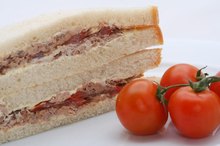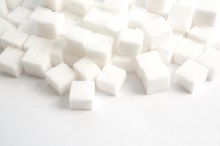What Are the Functions of Simple Carbohydrates?
Carbohydrates fall into the categories of “simple” and “complex” -- known more commonly as sugars and starches. Simple carbohydrates, or sugars, fulfill the same roles in the body as complex carbohydrates, despite the different taste. Both provide energy to cells and can be used immediately or stored for later use in one of two forms.
Carbohydrates
Carbohydrates are one of the three macronutrients, which are compounds that you need in large quantities as components of your diet and which provide energy to your cells. All nutritional carbohydrates consist of one or more building-block units called monosaccharides, explain Drs. Reginald Garrett and Charles Grisham in “Biochemistry.” Complex carbohydrates, or starches, consist of long chains of monosaccharides; simple carbohydrates are made of only one or two monosaccharides 1.
Eating Simple Carbohydrates
What Do Carbohydrates, Lipids & Proteins Have in Common?
Learn More
Several common simple carbohydrates are routinely included as part of your diet. These include glucose and fructose, which are single monosaccharides, and sucrose and lactose -- table sugar and milk sugar, respectively – each of which consists of two monosaccharides linked together. Glucose and fructose do not require digestion before absorption. Sucrose and lactose, however, must be broken down into their monosaccharide components before they are taken into your bloodstream.
- Several common simple carbohydrates are routinely included as part of your diet.
- Sucrose and lactose, however, must be broken down into their monosaccharide components before they are taken into your bloodstream.
Immediate Energy
Once you absorb monosaccharides from simple carbohydrates into the bloodstream, your cells take them up and can burn them for immediate energy. Glucose, in particular, is a favorite fuel of the brain and working muscles. While you can burn any of the macronutrients for energy -- constituents of fats and proteins also provide energy to cells -- only monosaccharides burn under anaerobic conditions, or circumstances in which oxygen is scarce. As such, you can use simple carbohydrates to fuel hard-working muscles that cannot burn protein or fat.
- Once you absorb monosaccharides from simple carbohydrates into the bloodstream, your cells take them up and can burn them for immediate energy.
- While you can burn any of the macronutrients for energy -- constituents of fats and proteins also provide energy to cells -- only monosaccharides burn under anaerobic conditions, or circumstances in which oxygen is scarce.
Stored Energy
Sucrose, Dextrose & Maltodextrin
Learn More
Simple carbohydrates provide your body with energy that can be stored for later use. If you consume more simple carbohydrates than you need, the cells can convert the excess into one of two storage forms, explain Drs. Mary Campbell and Shawn Farrell in “Biochemistry.” Glycogen, stored by the liver and muscles, is a carbohydrate-based compound formed from monosaccharides 2. Monosaccharides can also be converted into fat, which is stored in adipose tissue.
- Simple carbohydrates provide your body with energy that can be stored for later use.
- If you consume more simple carbohydrates than you need, the cells can convert the excess into one of two storage forms, explain Drs.
Related Articles
References
- “Biochemistry”; Reginald Garrett, Ph.D. and Charles Grisham, Ph.D.; 2007
- “Biochemistry”; Mary Campbell, Ph.D. and Shawn Farrell, Ph.D.; 2005
- Carr, T. P., Gropper, S. S., Smith, J. L. (2016). Advanced Nutrition and Human Metabolism. United States: Cengage Learning.
- U.S. Department of Health and Human Services and U.S. Department of Agriculture. 2015–2020 Dietary Guidelines for Americans. 8th Edition. Published December 2015.
Writer Bio
Kirstin Hendrickson is a writer, teacher, coach, athlete and author of the textbook "Chemistry In The World." She's been teaching and writing about health, wellness and nutrition for more than 10 years. She has a Bachelor of Science in zoology, a Bachelor of Science in psychology, a Master of Science in chemistry and a doctoral degree in bioorganic chemistry.









